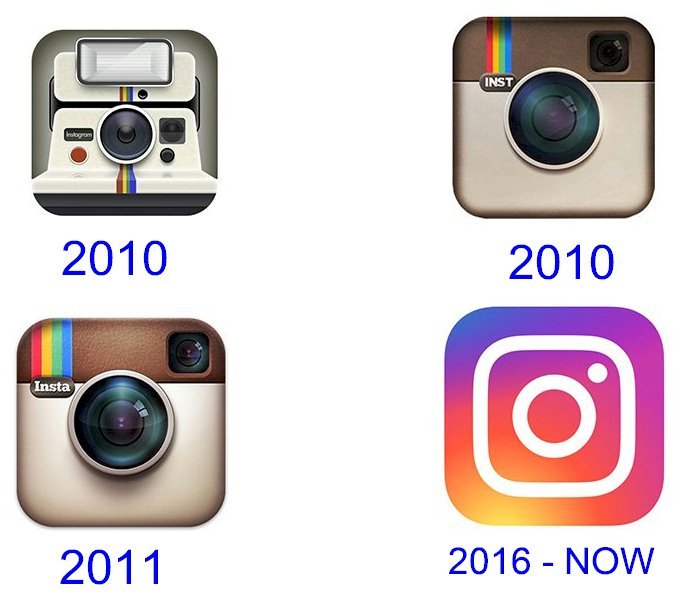This is a look at the Instagram Logo and the history behind the company.
In 12 years, the Instagram logo is serving nearly 500 million active daily users – this is incredible popularity. These loyal users will continue to associate with the Instagram brand for many years to come. Also, the parent company–Facebook, and its iconic leader–Mark Zuckerberg, will never cease to garner free publicity from the local and international media that need controversial content to feed their audiences.

A picture is worth a thousand words–this adage could be one reason companies spend immense sums of money getting their logo and branding strategies right. Before 2010, no one envisions a photo-sharing app would be worth billions of dollars while forming the income source for many other brands. The Instagram logo is prominent almost everywhere you look, It’s on phones, storefronts, billboards, and many more places.
Instagram is another successful start-up from Silicon Valley, the tech hub of the world. Instagram is a portmanteau for ‘instant’ and ‘telegram.’ Today, what started as a mobile-check app in 2010 has become the largest photo and video-sharing platform, and one of the most recognizable brands in the world.
Instagram, as of June 2020, has one billion active users across the world, comprising 52% females and 48% males. Instagram holds its success and popularity to its mobile-friendly interface, better story integration, and friendly e-commerce interface. Also, its easy content discovery is another factor. The Instagram colorful logo has played a leading role in this popularity. It has represented the app to its greatness.
Let’s explore the Instagram logo and some history behind the app and business model. The iconic Instagram logo has helped it to become one of the most recognizable brands in the world.
The History of the Instagram Logo

Smart entrepreneurs know the power behind logo designs and the impact they can make on people and their overall corporate branding. Therefore, they strive hard to keep their logo updated to remain relevant to the changes in their industries. The Instagram logo, like many before it, has evolved over the last ten years. The Instagram logo design has seen three incredible changes.
Kevin Systrom, the co-founder, designed the original logo in 2010. To represent what Instagram stood for at the time–photo sharing, he chose a Polaroid camera with a rainbow stripe.
Later the same year, however, Kevin and his team agreed to outsource the services of Cole Rise, a professional photographer, and designer. Kevin loved the new logo, which took inspiration from Bell & Howell camera from the 1950s. Cole Rise’s logo design achieved instant fame, and the company used it until 2016.
When Instagram rolled out its third logo design, the internet went buzzing with negative comments. The 2016 logo design, though looks entirely different, is an outline illustration of the unique Polaroid camera image. The rainbow stripes, which have been outstanding in the previous logo, were removed. Despite the backlash, the new minimalist logo design remains unchanged. Robert Padbury was the designer behind the new creation.
Design Elements of the Instagram Logo

Today, Instagram is more than a photo-sharing app. Integrating video-sharing, social media networking, and advertising makes it one of the most addictive apps in the world. It has grown to become so beneficial that celebrities and advertisers can’t have enough of it.
The Instagram logo, from all indications, has not lost its element of design. The current skewed square and circle still represent the old Polaroid camera. This element of the Instagram Logo signifies focus, nostalgia, youthfulness, and memories. Sharing colorful moments with friends and loved ones has been the focus of the app since its beginning.
The IG logo is all about colors. The app’s owners have never hidden this from the world. Photos and videos are the primary sources of colors since they get their contents from nature. Most of the colors on the Instagram logo are warm colors that represent enthusiasm and energy.
Well, let’s hear from Ian Spalter, head of design at Instagram: “Color has always been a huge part of Instagram—you see it in the classic app icon, filters, and the community’s photos and videos. When we started reimagining the rainbow, we looked at more minimal options, but ultimately we needed more warmth and energy to complement the glyph. While the logo is a colorful doorway into the Instagram app, once inside the app, we believe the color should come directly from the community’s photos and videos.”
The History of Instagram
Instagram is the brainchild of Kevin Systrom and Mike Krieger. They created the app in 2010 and named it Burbn, a mobile check-in app similar to foursquare. Since Burbn looked like foursquare and with some cutters, the founders shifted the focus of the app to photo-sharing.
On March 5, 2010, two venture capitalists from Baseline Ventures and Andreessen Horowitz provided seed funding of $500,000 to Kevin to pursue his entrepreneurial passion. With this funding in place, Instagram attracted some brains to the company–Josh Riedel as a community manager (in October 2010), Shayne Sweeney as an engineer (in November 2010), and Jessica Zollman as an evangelist (in August 2011).
To help its users find photos and each other easily, Instagram launched a feature called ‘hashtag’ in January 2011. To prevent generic tagging, it encourages users to use specific and relevant hashtags. Benchmark Capital, an investor, valued Instagram at around $25 million in February 2011. With this valuation, the likes of Jack Dorsey, Chris Sacca, and Adam D’Angelo invested a total of $7 million.
In February 2012, Instagram introduced ‘Lux Filler’ -a feature that lightens shadows, darkens highlights, and increases contrast.
The series ‘B’ fundraising took place in April 2012. By this time, Instagram value has grown to around $500 million. This estimated value attracted more venture capitalists, including Joshua Kushner, the owner of Thrive Capital. Instagram raised $50 million, and Kushner became the second-largest investor.
Instagram launched ‘Explore’-another powerful feature in June 2012. The ‘Explore’ feature displays popular photos, trending tags, curated contents, and it can search for locations. In November 2012, Instagram introduced ‘Website Profile’–a feature that allows people to see users’ feeds from a web browser.
Android phone users had their feel and taste of the app on April 3, 2012. In less than 24 hours, potential users downloaded the app over one million times–an unprecedented moment for the app creators. Six days after the release of the app on android phones, Mark Zuckerberg and his Facebook Empire bought Instagram for $1 billion in cash and stock.
Also, Facebook, the parent company, is a massive virtual economy in the world with a population of about 2.6 billion people and one of the most popular and influential brands in the world. Hence, anything that associates itself with Facebook instantly becomes popular. Facebook extended this aura of influence on Instagram when it bought it for $1 billion. The Facebook brand, and the amount involved in the purchase, are enough to get the media and people talking.
In September 2018, the announcement of the founders, Krieger and Systrom, to walk away from the product they have created shocked the world. It was an emotional moment, but massive publicity for the app and its logo. Why? Because the media couldn’t stop talking about it.

The deal encountered a few issues which were resolved officially on September 6, 2012, allowing Facebook to offer a purchase price of $300 million in cash and $23 million in stock. Wired, an American magazine, reported that Kevin Systrom made $400 million from the sale of Instagram–a sacrifice well compensated.
In June 2013, Instagram added a feature that allows its users to share a 15-second video with their friends and loved ones. Instagram launched ‘Instagram Direct’ in December 2013, a feature that allows users who follow each other to send private messages with photos and videos.
In June 2015, Instagram replaced the angular picture profiles with circular ones. It also made the Instagram desktop interface minimalistic and flat to look like a mobile website. This change, however, provided enough screen space for sharing photos.
Microsoft had had the beta version of Instagram since 2013. So, it was a dream come true for Microsoft to have Instagram launched ‘Windows 10 Mobile App’ in April 2016. The new app supports video viewing, post-creating, live streams, and photo album.
In August 2016, Instagram launched ‘Instagram Stories’–a feature that allows its users to take photos, enhance them with effects and layers, and finally add them to their Instagram stories. Likewise, Instagram introduced ‘Comment Liking’ in December of the same year.
Krieger and Systrom, the founders of Instagram, announced their decision to resign from Instagram in September 2018. The same year, and precisely in October, Instagram appointed Adams Mosseri as the new head of Instagram.
In March 2020, the impacts of COVID–19 led Instagram to release ‘Co-Watching’–a feature that allows users to share posts over video calls. This feature was a timely answer for virtually connecting with friends and loved ones, as governments told citizens to observe social distancing. In August 2020, Instagram released ‘Instagram Reels’–an additional feature that mimics the functions of TikTok. Similarly, Facebook started merging Instagram Direct into Facebook Messenger the same month.
The Instagram app has seen a lot of innovation after Facebook acquired it. A few of the features include IGTV Ads, Facebook Shop, Instagram Shop, Live Shopping, and Messenger Rooms.







